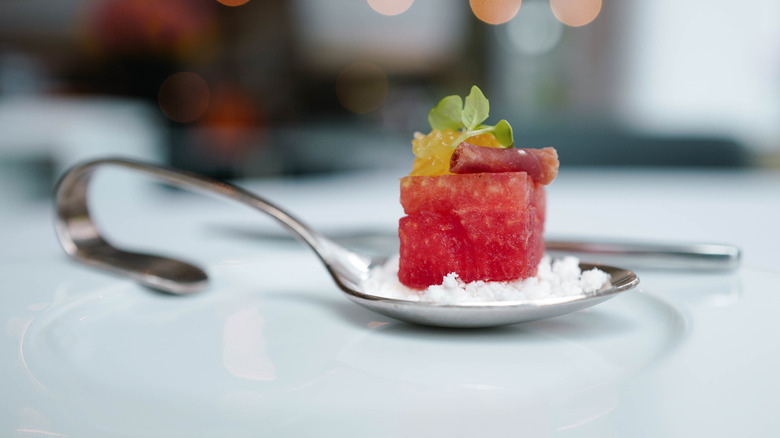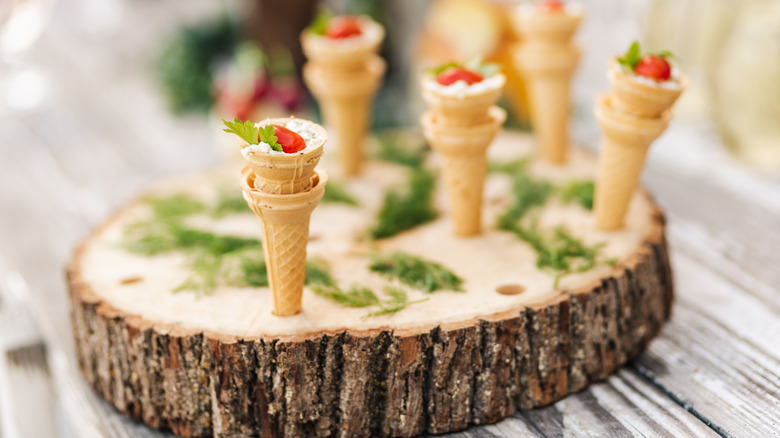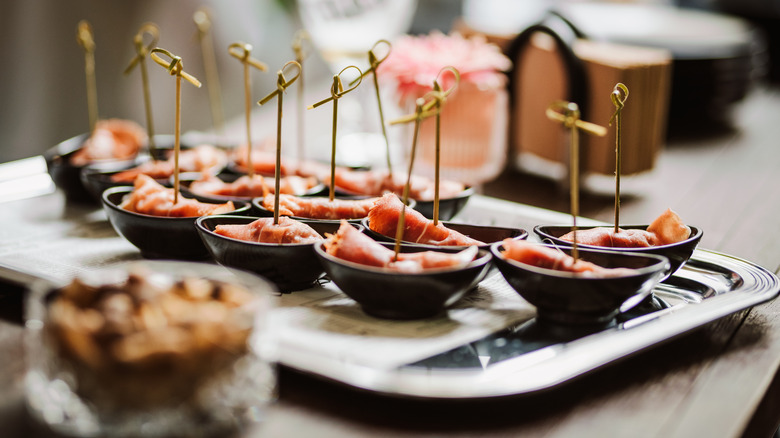What, Exactly, Is An Amuse-Bouche (And How Do You Eat One)?
If you find exquisite-looking, bite-sized morsels waiting for your party — even before you've ordered at a fine dining restaurant — don't be confused. Just put it in your mouth and brace for a brief culinary adventure. It's all part of the amuse-bouche experience — the realm where an entire course fits in a shot glass, tasting spoon, or tiny plate. Technically, the amuse-bouche is not a course in itself but a semi-colon between courses. However, it can sometimes also be the most memorable part of your meal.
Generally packed with intense or unfamiliar flavors, these small culinary creations are a sort of gift from the chef meant to make diners feel special. They are the opposite of regular appetizers in the sense that an amuse-bouche places novelty over practicality. Unless you frequent the same fancy restaurant regularly, an amuse-bouche will feature some aspect that's completely new to you. Sometimes, it can be as simple as an entire dish shrunk down to a bite, complete with garnishing — for example, a loaded shrimp cocktail featuring a single shrimp.
With its growing popularity, amuse-bouche is not restricted to high-end dinners and cocktail parties but has found its way to more conventional get-togethers. It's a nice surprise for guests, a showcase of the chef's skills, and can easily become a way for the host to reinforce the dinner's theme.
Amuse-bouche is literally an amusement for your mouth
Amuse-bouches, French for "mouth amusers," could be compared to Super Bowl commercials; they are not the centerpiece but small bits of creative entertainment surrounding the main event. You'll also find them at cocktail parties; due to their small size, they make excellent one-handed snacks that can be consumed while standing around hobnobbing.
Amuse-bouches or amuse-gueules originated around the time of nouvelle cuisine, when chefs specializing in French cuisine started favoring natural, seasonal flavors over rich sauces. Often, it is not just flavors but even smells, colors, and overall appearance of the miniature culinary creations that chefs will play around with. Something as simple as a small amount of intensely-flavored soup of fall or spring vegetables in an espresso cup was and is a popular template.
The line between hors d'oeuvres, appetizers, and amuse-bouches can get blurry, especially when you consider that all three are meant to whet the diners' appetites. The bold, often exotic presentation and experimental flavor combinations of amuse-bouches are what set them apart. The fact that amuse-bouches are not added to the bill plays an important role since it allows chefs to be more whimsical with their culinary creativity. It's also a great way to try a new dish before adding it to the menu officially.
An amuse bouche should be eaten in one bite (most of the time)
There's almost always a clue as to how the chef intends for it to be eaten telegraphed in the presentation. For example, anything in a shot glass or tasting spoon is meant to be consumed in one bite. However, that espresso cup of soup doesn't need to be downed in one gulp, especially because its intense flavor is best enjoyed when sipped. The size of the amuse-bouche is also an indicator of how to eat it. If a crostini with topping looks too big to fit in your mouth, eat it in two bites. Though hors d'oeuvres are often designed to be eaten by hand, this can vary due to the experimental nature of amuse-bouche. Since it is not an official part of the menu, the amuse-bouche tends to be a self-contained unit. If it's meant to be eaten with cutlery, it will be supplied.
More than anything, it's important not to get intimidated by an amuse-bouche, no matter how exotic it looks, but to enjoy the experience of eating it. And the next time you're hosting, surprise guests with your own amuse-bouche creations. Start simple with some tapas-inspired liquid olives and work your way up to more complicated dishes like Thomas Keller's ice cream cone-inspired salmon tartare tuiles.


